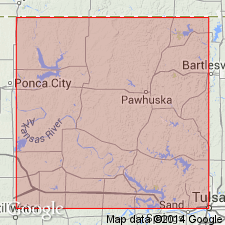
- Usage in publication:
-
- Possum sandstone*
- Modifications:
-
- Original reference
- Dominant lithology:
-
- Sandstone
- AAPG geologic province:
-
- Chautauqua platform
Summary:
Pg. 330, 332. Possum sandstone member of Nelagoney formation. The first sandstone of prominence below Cheshewalla sandstone in T. 29 N., R. 11 E., being separated from the Cheshewalla by 75 to 100 feet of shale containing several lenticular sandstones which together occupy 50+/- feet of the interval. The Possum sandstone is therefore = part of Revard sandstone, probably lying at or near top of that sandstone. In western part of its area it is a soft massive bed, the freshly broken surface of which shows some discontinuous bedding lines, and is generally covered with rusty or blackish specks as much as one-eighth inch diameter. To the east, in sec. 32, T. 29 N., R. 12 E., the bed thins abruptly, changes to a hard, platy greenish limy or sideritic sandstone a few inches thick, and within a few feet disappears entirely. Age is Pennsylvanian.
Named from occurrence as a prominent ledge along sides of Opossum Creek, in southeast corner of T. 29 N., R. 11 E., Osage Co., north-central OK.
Source: US geologic names lexicon (USGS Bull. 896, p. 1712).
For more information, please contact Nancy Stamm, Geologic Names Committee Secretary.
Asterisk (*) indicates published by U.S. Geological Survey authors.
"No current usage" (†) implies that a name has been abandoned or has fallen into disuse. Former usage and, if known, replacement name given in parentheses ( ).
Slash (/) indicates name conflicts with nomenclatural guidelines (CSN, 1933; ACSN, 1961, 1970; NACSN, 1983, 2005, 2021). May be explained within brackets ([ ]).

